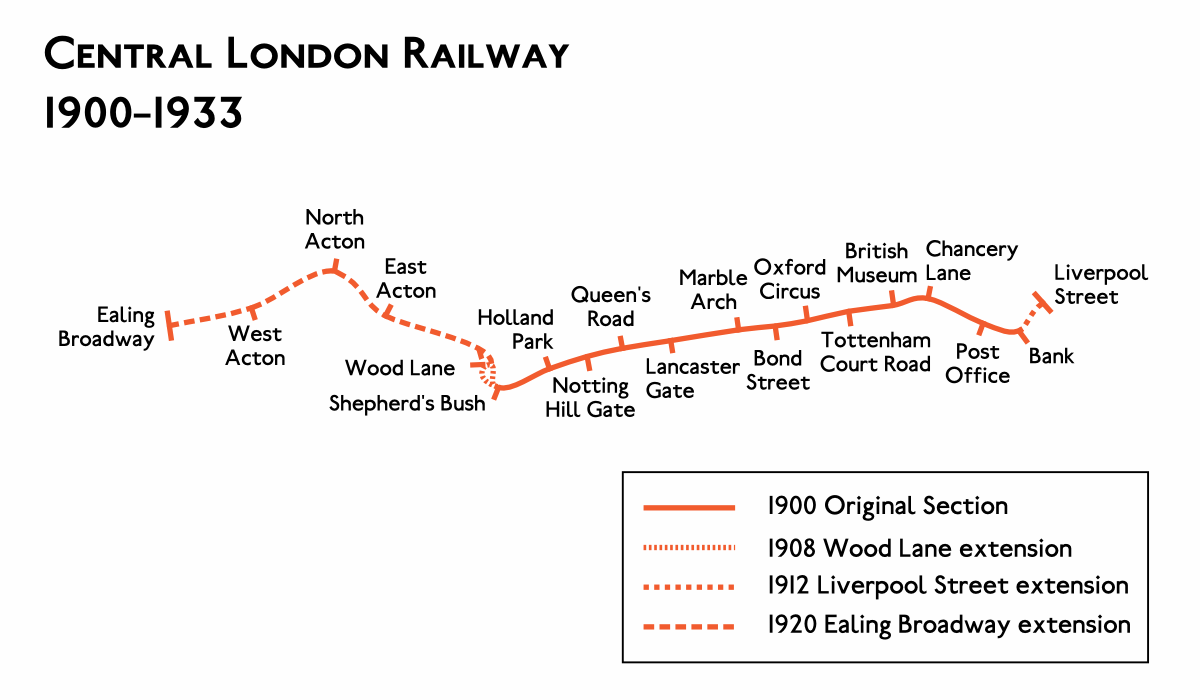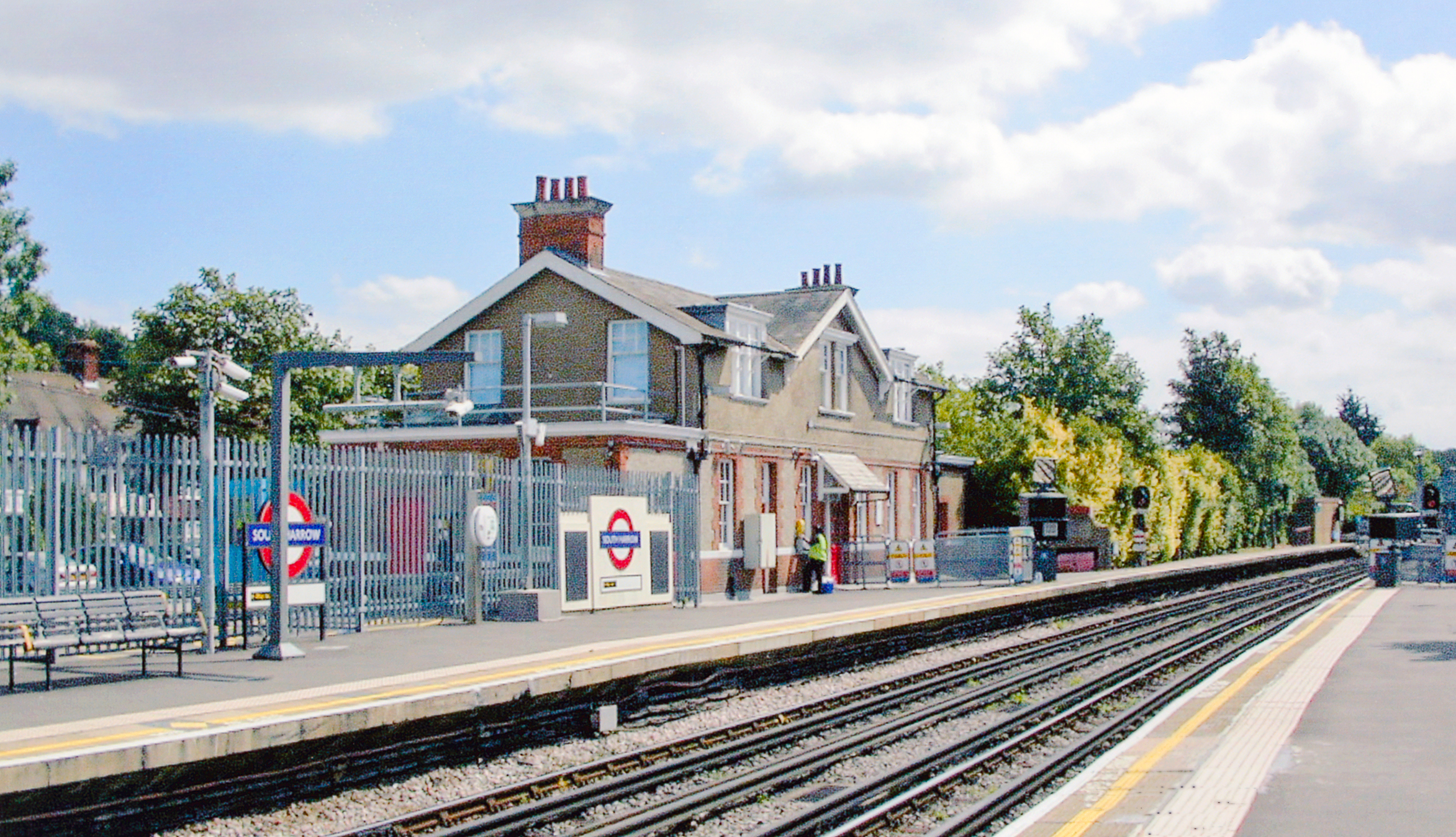|
Ealing Common Tube Station
Ealing Common is a London Underground station in the London Borough of Ealing. It is served by the District and Piccadilly lines, and is located in Travelcard Zone 3. On the Ealing Broadway branch of the District line, the station is between Ealing Broadway and Acton Town stations. On the Uxbridge branch of the Piccadilly line, it is between North Ealing and Acton Town stations. It is the only station west of Acton Town to be served by both the District and Piccadilly lines. The station is located in Ealing on the Uxbridge Road ( A4020), about east of the junction with Gunnersbury Avenue and Hanger Lane ( A406, North Circular Road) and the Ealing Common open space the station takes its name from. History Ealing Common station was opened on 1 July 1879 by the District Railway (DR, now the District line) on its extension from Turnham Green to Ealing Broadway. From 1886 until 1 March 1910 the station was known as Ealing Common and West Acton after which it changed to it ... [...More Info...] [...Related Items...] OR: [Wikipedia] [Google] [Baidu] |
London Underground
The London Underground (also known simply as the Underground or as the Tube) is a rapid transit system serving Greater London and some parts of the adjacent home counties of Buckinghamshire, Essex and Hertfordshire in England. The Underground has its origins in the Metropolitan Railway, opening on 10 January 1863 as the world's first underground passenger railway. The Metropolitan is now part of the Circle line (London Underground), Circle, District line, District, Hammersmith & City line, Hammersmith & City and Metropolitan lines. The first line to operate underground electric locomotive, electric traction trains, the City & South London Railway in 1890, is now part of the Northern line. The network has expanded to 11 lines with of track. However, the Underground does not cover most southern parts of Greater London; there are only 33 Underground stations south of the River Thames. The system's List of London Underground stations, 272 stations collectively accommodate up ... [...More Info...] [...Related Items...] OR: [Wikipedia] [Google] [Baidu] |
Park Royal & Twyford Abbey Tube Station
Park Royal & Twyford Abbey was a London Underground station on the District Railway (now the District line), on a route now utilised by the Uxbridge branch of the Piccadilly line. It opened in 1903. It was located near Twyford Abbey Road, a short distance north of the current Park Royal station which replaced it in 1931. History The station was opened on 23 June 1903 by the District Railway on a new branch line to South Harrow and Metropolitan line tracks at Rayners Lane. Park Royal & Twyford Abbey was intended to serve the recently opened Royal Agricultural Society showgrounds at Park Royal; however, despite the proximity of the station (and another to the east on what is now the Central line), the showgrounds were not successful and closed after only a few years. The second part of the station's name was adopted from the nearby Twyford Abbey. The station closed permanently on 5 July 1931 to be replaced the following day by a new Park Royal station built for the extensi ... [...More Info...] [...Related Items...] OR: [Wikipedia] [Google] [Baidu] |
Northern Line
The Northern line is a London Underground line that runs between North London and South London. It is printed in black on the Tube map. It carries more passengers per year than any other Underground linearound 340million in 2019making it the busiest tube line in London. The Northern line is unique on the network in having two different routes through Central London, two northern branches and two southern branches. Despite its name, it does not serve the northernmost stations on the Underground, though it does serve the southernmost station at Morden tube station, Morden, the terminus of one of the two southern branches. The line's northern termini, all in the London Borough of Barnet, are at and ; is the terminus of a single-station branch line off the High Barnet branch. The two main northern branches run south to join at where two routes, one via in the West End of London, West End and the other via in the City of London, City, continue and then join at in London Boroug ... [...More Info...] [...Related Items...] OR: [Wikipedia] [Google] [Baidu] |
Morden Tube Station
Morden is a London Underground station in Morden in the London Borough of Merton. It is the southern terminus of the Northern line, and is the most southerly station on the Underground network. It is located on London Road (the A24 road (Great Britain), A24), and is in Travelcard Zone 4. Nearby are Morden Hall Park and Morden Park. The next station towards North London is South Wimbledon tube station, South Wimbledon. The station was one of the first Modern architecture, modernist designs produced for the London Underground by Charles Holden. Its opening in 1926 contributed to the rapid development of new suburbs in what was previously a rural part of Surrey; the population of the parish increased ninefold in the decade 1921–1931. History Following the end of the First World War, the Underground Electric Railways Company of London (UERL) began reviving a series of prewar plans for line extensions and improvements that had been postponed during the hostilities. Finance for t ... [...More Info...] [...Related Items...] OR: [Wikipedia] [Google] [Baidu] |
Charles Holden
Charles Henry Holden (12 May 1875 – 1 May 1960) was an English architect best known for designing many London Underground stations during the 1920s and 1930s, the Underground Electric Railways Company of London's headquarters at 55 Broadway, for the University of London's Senate House and for Bristol Central Library. He created many war cemeteries in Belgium and northern France for the Imperial War Graves Commission. After working and training in Bolton and Manchester, Holden moved to London. His early buildings were influenced by the Arts and Crafts Movement, but for most of his career he championed an unadorned style based on simplified forms and massing that was free of what he considered to be unnecessary decorative detailing. Holden believed strongly that architectural designs should be dictated by buildings' intended functions. After the First World War, he increasingly simplified his style and his designs became pared-down and modernist, influenced by European arc ... [...More Info...] [...Related Items...] OR: [Wikipedia] [Google] [Baidu] |
Central London Railway
The Central London Railway (CLR), also known as the Twopenny Tube, was a deep-level, underground "tube" railwayA "tube" railway is an underground railway constructed in a cylindrical tunnel by the use of a tunnelling shield, usually deep below ground level. Contrast " cut and cover" tunnelling. that opened in London in 1900. The CLR's tunnels and stations form the central section of what became London Underground's Central line. The railway company was established in 1889, funding for construction was obtained in 1895 through a syndicate of financiers and work took place from 1896 to 1900. When opened, the CLR served 13 stations and ran completely underground in a pair of tunnels for between its western terminus at Shepherd's Bush and its eastern terminus at the Bank of England, with a depot and power station to the north of the western terminus.Length of line calculated from distances given at After a rejected proposal to turn the line into a loop, it was extended at the wes ... [...More Info...] [...Related Items...] OR: [Wikipedia] [Google] [Baidu] |
Waterloo And City Railway
The Waterloo & City line, colloquially known as The Drain, is a shuttle line of the London Underground that runs between Waterloo and Bank stations with no intermediate stops. Its primary traffic consists of commuters from south-west London, Surrey and Hampshire arriving at Waterloo main line station and travelling forward to the City of London financial district. For this reason, the line has historically not operated on Sundays or public holidays, except in very limited circumstances. Following the COVID-19 pandemic, the line is currently only open on weekdays. It is one of only two lines on the Underground network to run completely underground, the other being the Victoria line. Printed in turquoise on the Tube map, it is by far the shortest line on the Underground network, being long, with an end-to-end journey lasting just four minutes. In absolute terms, it is the least-used Tube line, carrying just over 17 million passengers annually. However, in terms of the a ... [...More Info...] [...Related Items...] OR: [Wikipedia] [Google] [Baidu] |
City And South London Railway
The City and South London Railway (C&SLR) was the first successful deep-level underground "tube" railway in the world, and the first major railway to use Railway electrification in Great Britain, electric traction. The railway was originally intended for cable-hauled trains, but owing to the bankruptcy of the cable contractor during construction, a system of electric traction using electric locomotives – an experimental technology at the time – was chosen instead. When opened in 1890, the line had six stations and ran for Length of line calculated from distances given at in a pair of tunnels between the City of London and Stockwell, passing under the River Thames. The diameter of the tunnels restricted the size of the trains, and the small carriages with their high-backed seating were nicknamed ''padded cells''. The railway was extended several times north and south, eventually serving 22 stations over a distance of from Camden Town in north London to Morden in south Lond ... [...More Info...] [...Related Items...] OR: [Wikipedia] [Google] [Baidu] |
Steam Locomotive
A steam locomotive is a locomotive that provides the force to move itself and other vehicles by means of the expansion of steam. It is fuelled by burning combustible material (usually coal, Fuel oil, oil or, rarely, Wood fuel, wood) to heat water in the locomotive's Boiler (power generation), boiler to the point where it becomes gaseous and its volume increases 1,700 times. Functionally, it is a steam engine on wheels. In most locomotives, the steam is admitted alternately to each end of its Steam locomotive components, cylinders in which pistons are mechanically connected to the locomotive's main wheels. Fuel and water supplies are usually carried with the locomotive, either on the locomotive itself or in a Tender (rail), tender coupled to it. #Variations, Variations in this general design include electrically powered boilers, turbines in place of pistons, and using steam generated externally. Steam locomotives were first developed in the United Kingdom of Great Britain an ... [...More Info...] [...Related Items...] OR: [Wikipedia] [Google] [Baidu] |
Electric Locomotive
An electric locomotive is a locomotive powered by electricity from overhead lines, a third rail or on-board energy storage such as a Battery (electricity), battery or a supercapacitor. Locomotives with on-board fuelled prime mover (locomotive), prime movers, such as diesel engines or gas turbines, are classed as Diesel–electric powertrain, diesel–electric or turbine–electric powertrain, gas turbine–electric and not as electric locomotives, because the electric generator/motor combination serves only as a Transmission (mechanics), power transmission system. Electric locomotives benefit from the high efficiency of electric motors, often above 90% (not including the inefficiency of generating the electricity). Additional efficiency can be gained from regenerative braking, which allows kinetic energy to be recovered during braking to put power back on the line. Newer electric locomotives use AC motor-inverter drive systems that provide for regenerative braking. Electric loco ... [...More Info...] [...Related Items...] OR: [Wikipedia] [Google] [Baidu] |
Electrification
Electrification is the process of powering by electricity and, in many contexts, the introduction of such power by changing over from an earlier power source. In the context of history of technology and economic development, electrification refers to the build-out of the electricity generation and electric power distribution systems. In the context of sustainable energy, electrification refers to the build-out of super grids and smart grids with distributed energy resources (such as energy storage) to accommodate the energy transition to renewable energy and the switch of end-uses to electricity. The electrification of particular sectors of the economy, particularly out of context, is called by modified terms such as Mass production#Factory electrification, ''factory electrification'', ''household electrification'', ''rural electrification'' and ''railway electrification''. In the context of sustainable energy, terms such as ''transport electrification'' (referring to electric v ... [...More Info...] [...Related Items...] OR: [Wikipedia] [Google] [Baidu] |
South Harrow Tube Station
South Harrow is a London Underground station in South Harrow, north-west London. It is on the Uxbridge branch of the Piccadilly line between Rayners Lane and Sudbury Hill stations. The station is located on Northolt Road ( A312). It is in Travelcard Zone 5. There are several bus stands outside the station as well as overnight train stabling sidings. History South Harrow station was opened on 28 June 1903 by the District Railway (DR, now the District line) as the terminus of its new extension from Park Royal & Twyford Abbey. This new extension was, together with the existing tracks back to Acton Town, the first section of the Underground's surface lines to be electrified and operate electric instead of steam trains. The Deep level tube lines open at that time ( City & South London Railway, Waterloo & City Railway and Central London Railway) had been electrically powered from the start. On 1 March 1910, the DR was extended north to meet the Metropolitan Railway (MR, n ... [...More Info...] [...Related Items...] OR: [Wikipedia] [Google] [Baidu] |









